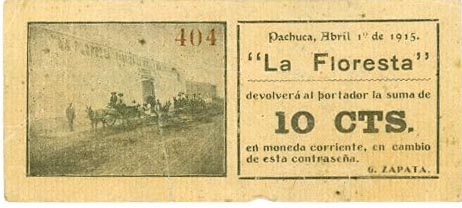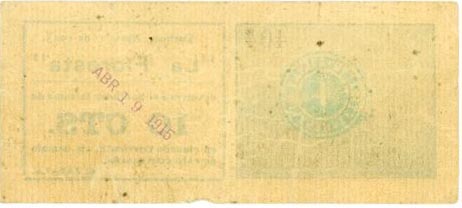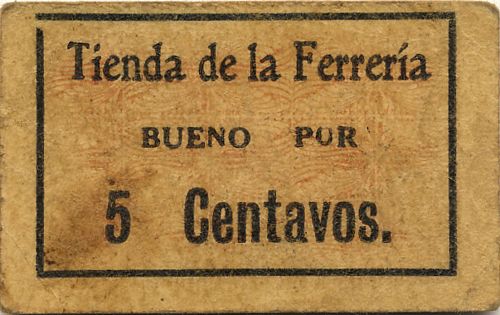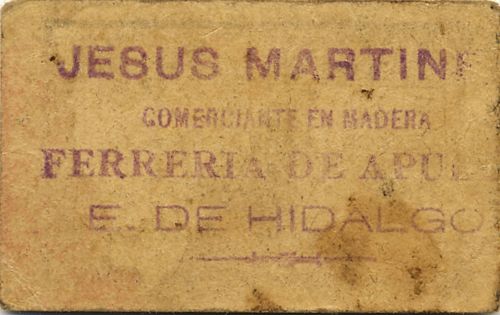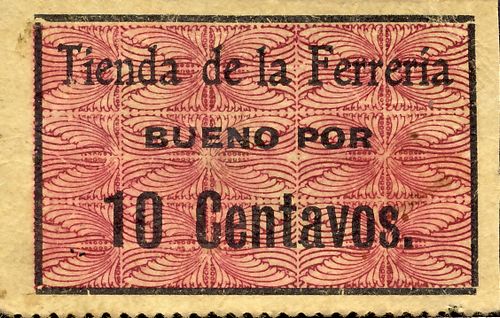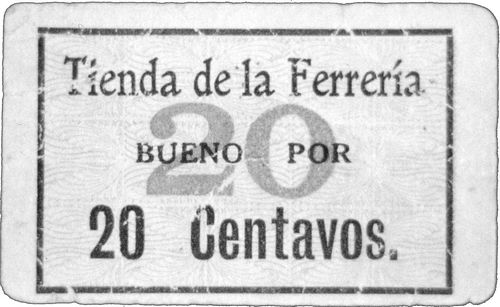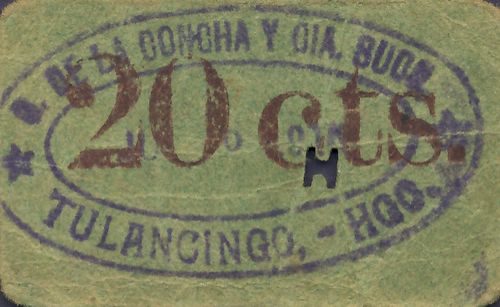Commercial concerns
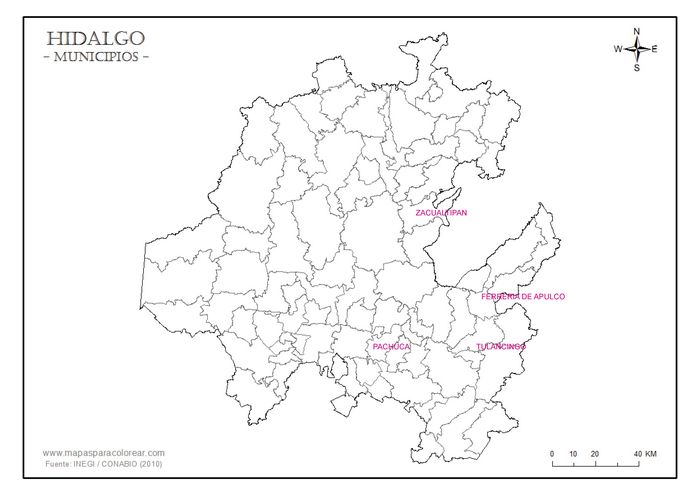 We know of various notes issued by local businesses.
We know of various notes issued by local businesses.
Zacualtipán
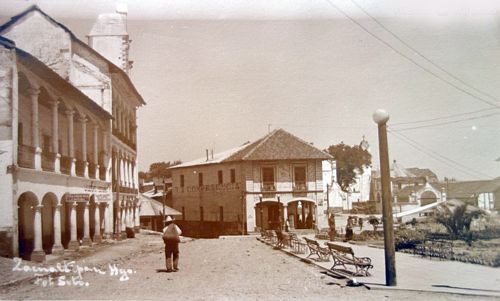 Zacualtipán is 100 kilometres north of Pachuca.
Zacualtipán is 100 kilometres north of Pachuca.
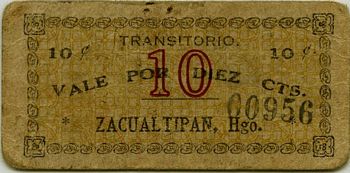
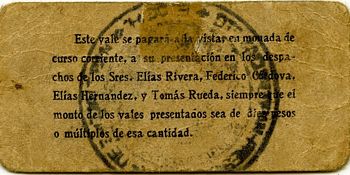
| from | to | total number |
total value |
||
| 10c | includes number 00956 |
This cartón has a rubber-stamped seal and the legend "Este Vale se pagará a la vista en moneda de curso corriente, a su presentación en los despachos de los Sres. Elías Rivera, Federico Cordova, Elías Hernández, y Tomás Rueda, siempre que el monto de los vales presentados sea de diez pesos o múltiples de esa cantidad". As these people ran tiendas mixtas this note will have been a communal venture, passable in a collection of stores and untimately redeemable in quantities of ten pesos.
La Benefactora
“La Benefactora” issued a vale for 20c, dated 24 May 1914 with the printed signatures of Ramón Rueda as Responsable (i.e. the peson guaranteeing the issue) and Ruben Ramírez as Interventor (the local authority's representative?). 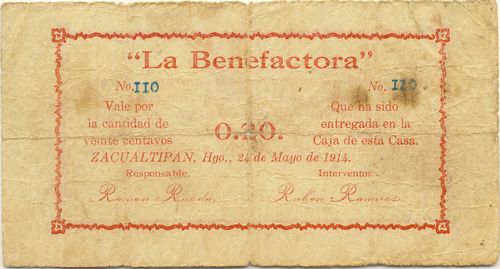
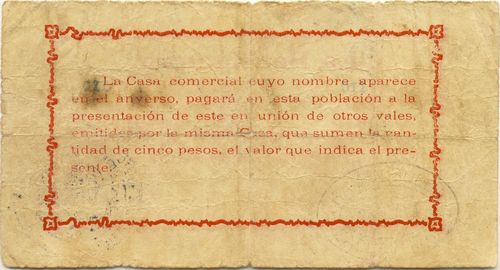
| from | to | total number |
total value |
||
| 20c | includes number 110 |
Ramón Rueda y Tejera (1852-1909) operated a tienda mixta: his son, Ramón Rueda Badillo, born in 1890, will have inherited the business. He was Presidente Municipal in 1911 and again in 1915-1917.
The text on the reverse reads ‘La casa comercial cuyo nombre aparece en el anverso, pagará en esta población a la presentación de este en unión de otros vales emitidos por la misma Casa, que sumen la cantidad de cinco pesos, el valor que indica el presente’ so this was one of a uniform series issued by different casas comerciales.
Tula de Allende
La Tolteca Compañía de Cemento Portland
This cement factory at San Marcos, Tula, was established in 1910 by some Americans who a short time later sold it to a British multinational.
Among the archives that were thrown into landfill by the new owners of the American Bank Note Company was correspondence from 1913-1914 on notes for the La Tolteca Compañía de Cemento PortlandABNC, 40238.00. This might have been for a proposed (and possibly effected) issue of notes, to be used to pay workers and suppliers, during the Revolution.
Pachuca
In his August 1915 report on local issues to the Secretaría de Gobernación in Veracruz, Arturo Lazo de la Vega records that certain casas comerciales had made small issue of 5c and 10c notes, but when told to stop had done soAGN, Fondo Gobernación Periodo Revolucionario, caja 93, exp. 36, folletos 8 Secretario general L. de la Vega to [ ], Pachuca, 20 August 1915.
"La Floresta"
| from | to | total number |
total value |
||
| 10c | includes number 404CNBanxico # |
"La Floresta" made and sold ice and fizzy drinks. It was owned by the Spaniards, Gonzalo Zapata and María Guadalupe CházaroEl Heraldo, Pachuca, 17 May 1908. In 1917 Zapata founded (or refounded) the local Chamber of Commerce.
Zapata issued a 10c note dated 1 April 1915 with the rather convoluted legend “devolverá al portador la suma de 10 CTS en moneda corriente, en cambio de esta contraseña”.
Cía. de Transmisión Eléctrica de Potencia del Estado de Hidalgo, S. A.
The Compañía de Transmisión Eléctrica de Potencia en el Estado de Hidalgo was founded by the English businessman Richard Honey with a capital of $380,000 and a 99-year concession. It provided energy to the mines of Pachuca, Real del Monte and San Rafael and built the hydroelectric plant "La Trinidad" at Acaxochitlán, Hidalgo, to supply energy to the city of Tulancingo.
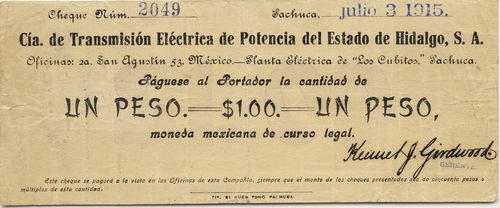
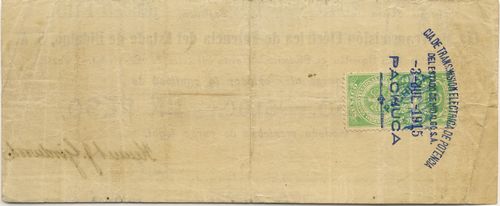
| date on note | from | to | total number |
total value |
||
| $1 | 8 May 1915 | includes number 412 | ||||
| 26 June 1915 | includes number 1940CNBanxico #11258 | |||||
| 3 July 1915 | includes number 2049 |
This is a $1 note similar to the ones issued by the Negociación Minera Hacienda Grande, Purísima y Minas de Guadalupe y Anexas and from the same Pachuca printers, the Tipografía El Buen Tono. These were redeemable in the company's office in the rather high amount of $50 or multiples.
These have the facsimile signature of the manager. Kennet J. Girdwood.
| Kennet J. Girdwood was an electrical engineer who was working in mining in El Oro by March 1905The Mexican Herald, vol. XX, no. 10, 10 March 1905; The Mexican Herald, vol. XXV, no. 106, 15 December 1907 until 1910The Mexican Herald, vol. XXX, no. 146, 24 August 1910. By 1911 he had moved to PachucaThe Mexican Herald, vol. XXXI, no. 158, 7 March 1911. |  |
La Compañía de Luz, Fuerza y Ferrocarriles de Pachuca
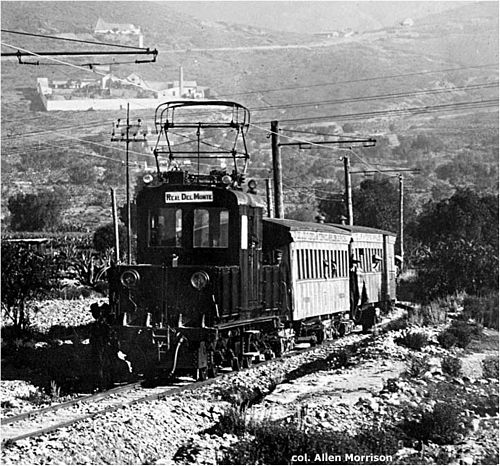
The Compañía de Luz, Fuerza y Ferrocarriles de Pachuca operated 21 miles (34 kilometres) of tram and railway track around Pachuca, including lines to Santa Gertrudis and Real del Monte to the east, and to San Rafael to the north.
In his August 1915 report on local issues to the Secretaría de Gobernación in Veracruz, Arturo Lazo de la Vega records that on 22 May 1915 governor General Alfredo J. Machuca agreed to a request from the Compañía de Luz, Fuerza y Ferrocarriles de Pachuca, S.A to issue 5c vales to help with making change on their streetcarsAGN, Fondo Gobernación Periodo Revolucionario, caja 93, exp. 36, folletos 8 Secretario general L. de la Vega to [ ], Pachuca, 20 August 1915. 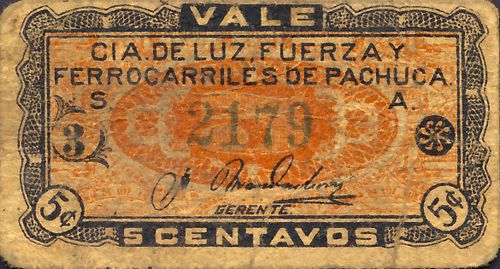
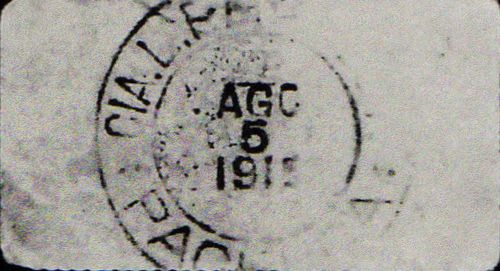
| from | to | total number |
total value |
||
| 5c | includes number 0382CNBanxico #4428 to 2179 |
This vale has the facsimile signature of Teodoro Brandenburg as Manager (Gerente) and the date handstamped on the back.
|
Teodoro Brandenburg was manager by May 1910La Patria, Año XXXIV, Núm. 9,613, 10 May 1910 and in that year served as president of the Casino of PachucaThe Mexican Herald, vol. XXIX, no. 150, 28 January 1910. In August 1926 he was the liquidator for the Compañía de Luz, Fuerzas y Ferrocarilles de Pachuca, S. A.Diario Oficial, Tomo XXXVII, Núm. 47, 24 August 1926 but stayed involved in developing railways. On 17 August 1931 he was named liquidator of the Compañía Manufacturera de Cemento Portland (“La Cruz Azul”) S.A. but the government intervened and arranged for the company to turn into a co-operative. |
 |
The number ‘3’ suggests that the vales were issued in uncut strips of [ ], with a common serial number (the examples in the Banco de México collection have serial numbers 0382 (5) and 1693 (6)).
In response to de la Vega’s report, on 9 September the Secretaría de Gobernación replied that the government should ascertain the size of the issue, ensure the company makes a deposit in the Tesorería General and, above all, fix a period for withdrawing this issueAGN, Fondo Gobernación Periodo Revolucionario, caja 93, exp. 36, folletos 8.
On 27 November 1915 it was reported that these notes, along with other issues, were being exchanged in the offices of the Tesorería for the currency issued by the local government, as approved by CarranzaEl Pueblo, Año II, Tomo II, Núm. 397, 29 November 1915.
So these vales will have been in use for a very limited period.
Ferrería de Apulco
Ferrería de Apulco is a town in the municipality of Metepec.
Jesús Martínez
The 10c note has the date 14 February 1915.
Tulancingo
Tulancingo is the second-largest city in the state, about 50 kilometres east of Pachuca.
Al Bazar Universal
The Bazar Universal of Gorgonio de la Concha y Compañía, Sucesores issued a variety of notes. The Bazar Universal was founded by the brothers Lorenzo and Juan Vizay(?) in [ ] and located in 1914 in the Plaza de la Constitución and Cuahutemoc.
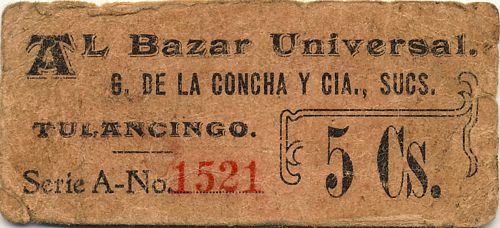
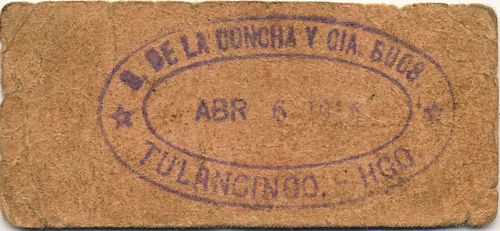
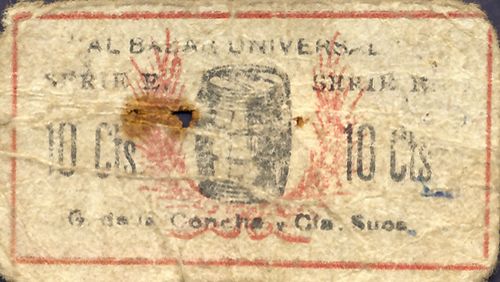
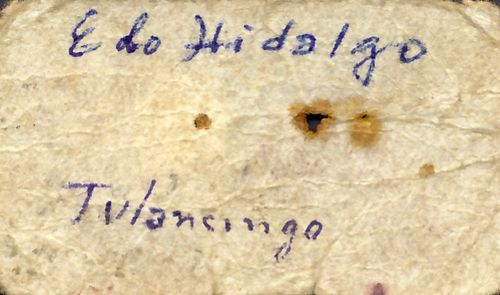
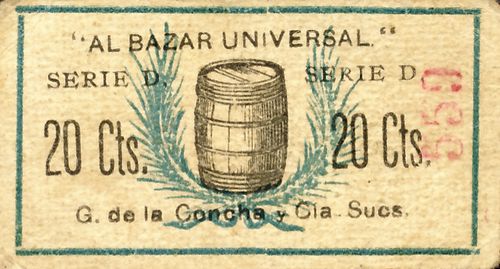
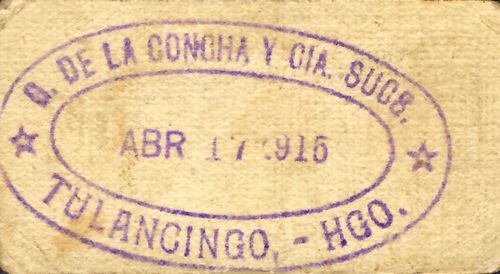
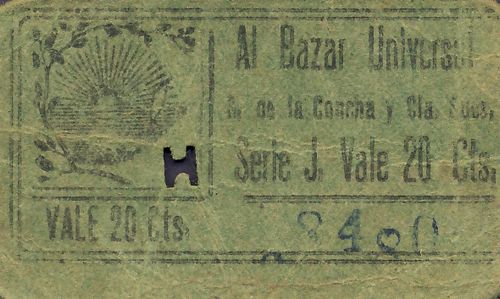
| series | date on note | from | to | total number |
total value |
||
| 5c | A | 6 April 1915 | includes number 1521 | ||||
| 10c | E | ||||||
| 20c | D | 17 April 1915 | includes numbers 559 to 3758CNBanxico #4436 | ||||
| J | 6 [ ] 1915 | includes numbers 8480 to 9941CNBanxico #4437{/footnote | |||||
| K | includes number 435[ ] |
"La Soledad"
"La Soledad", of Manuel de la Concha é hijo, was a clothing factory, situated at 4ª. de Zaragoza 31.
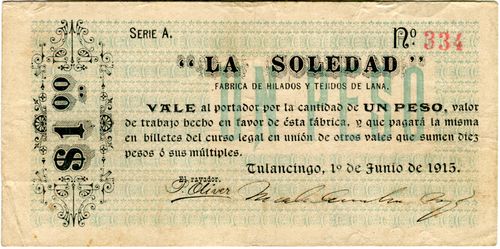
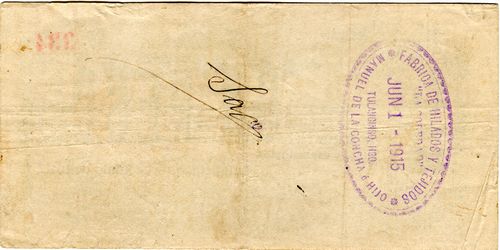
| Series | Date on note | from | to | total number |
total value |
||
| $1 | A | 1 June 1915 | includes numbers 334 to 1003datestamped 21 August 1915 | ||||
| C | includes number 184datestamped 13 September 1915 |
The text reads 'VALE al portador por la cantidad de UN PESO, valor de trabajo hecho en favor de ésta fábrica, y que pagará la misma en billetes del curso legal en union de otros vales que sumen diez pesos ó sus múltiples'.
The Series A note has the printed date of 1 June 1915. The Series C note has an extra line printed at the bottom setting a time limit of three months.
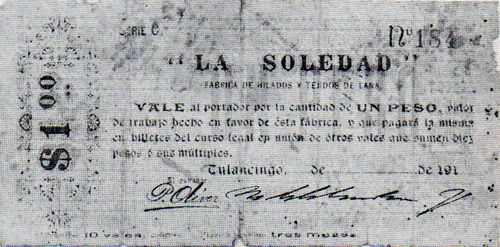
The notes are signed by the paymaster (rayador) P. Oliver and M. de la Concha [ ].
| P. Oliver | 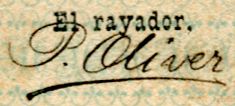 |
|
The elder Manuel de la Concha was the son of Martín de la Concha, who arrived in Mexico in the second half of the nineteenth century (probably between 1850 and 1870). Martín had twelve children, including Gorgonio, who became one of the most important businessmen in Tulancingo, and Manuel, who achieved slightly less prominence. Manuel married Soledad Ponce and had two children, Manuel and Esperanza. They lived in the house built by his father on the corner of calles Juárez and Zaragoza, which today is the Colonial Hotel, one of the few preserved buildings from the beginning of the century that exist in Tulancingo. Manuel de la Concha Ponce lived to be seventy-six years old. |
 |
Acaxochitlán
La Conquistadora
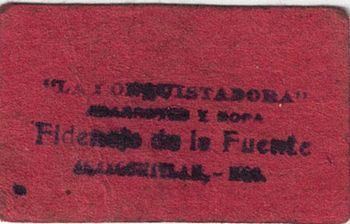
This grocery and clothes shop was run by Fidencio de la Fuente.
Honey
For Julio Hernández in Honey see the entry in Puebla.

